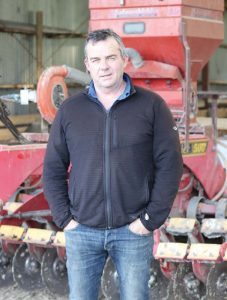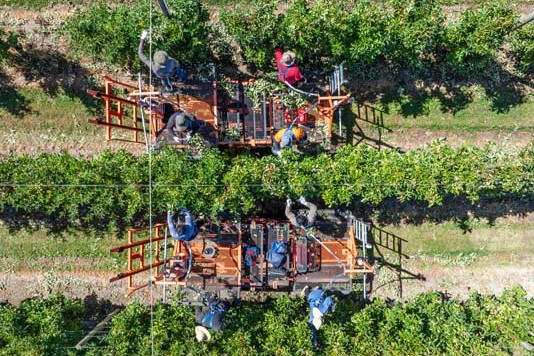Southland farmer Steve Wilkins foresees dairy farmers growing their own grain onfarm for stock feed. Story and photos by Karen Trebilcock.
 Steve Wilkins is a sheep and beef farmer at Athol, on the road between Queenstown and Te Anau, but he also grows grain and sends it to the nearby dairy farms the Wilkins family has interests in.
Steve Wilkins is a sheep and beef farmer at Athol, on the road between Queenstown and Te Anau, but he also grows grain and sends it to the nearby dairy farms the Wilkins family has interests in.
What they do – the integration of dairy and arable – he believes is the future for New Zealand with benefits not only for the economics of producing milk, but also an answer to lowering greenhouse gas emissions (GHGs) and reducing nutrient losses on dairy farms.
“Thirty to 40 years ago, before the dairying boom, most dairy farmers had some sort of cropping on their farms. It’s only recently we’ve had a monoculture of just grass,” Steve said.
“The focus today is on milksolids per hectare and the less-attractive parts of the business are left for someone else to do and I think that needs to change so we have more sustainable farming operations.”
A 2013 Nuffield scholar, who researched the synergies between arable and dairy, he said he came back from the experience with more questions than answers but saw firsthand the futility of having grain growing for animal feed in one part of a country and the animals to eat it on the other.
“In the UK, most of the cereal crops are grown on the east side and the animals are on the west. The United States is similarly divided.
“It means there are logistics and costs to get the feed grain to the animals.
“In New Zealand, we do have arable farms throughout the country next to dairy, beef and sheep operations but we could still do it a lot better.”
Steve said what other countries did excel in was capturing nutrients from dairy cattle for use to grow grass or crops.
“Because most of our cows are not wintered on pads or inside, we lose a lot of the nutrients, especially when paddocks are left bare in the winter months before sowing.”
If those nutrients were instead captured on feed pads, growing grain could use them.
“In the arable industry we know it takes 26kg of nitrogen to grow a tonne of grain but that includes the residual N in the soil as well.
“And on a dairy farm, a lot of that nitrogen could be from captured effluent.

“Or, if you get the grain sown quickly enough after a winter crop is eaten, it can soak up most of the nutrients, especially nitrogen, in the soil before they are leached away.”
Plus, growing grain reduced GHGs as there was no methane produced.
“The carbon produced is part of the carbon cycle. And a lot of the carbon is returned to the soil in the stubble which is incorporated before resowing so it’s stored.”
On his farm at Athol, his GHG figure was “very low” due to the grain grown.
“We have stock for the rotation of the different arable crops plus we use store lambs to eat the grass seed paddocks which increases our GHGs.”
A greater variety of birds and beneficial insects were also attracted to areas growing grain, another tick for the environment.
What farmers grew would depend on their feed requirements for their cattle as well as their soil conditions and expert advice was always available.
“Barley doesn’t like water-logged soils or the cold but otherwise it’s the most resilient to grow. Oats will germinate in wet and cold conditions. However, wheat has the best energy as a feed per hectare grown.
“But at different times of the year cattle need different nutrient levels to balance out the grass, so sometimes they need higher levels of protein and at other times, in spring when the grass is lush, they need energy, especially to get in-calf.”
Vice-chair of the Foundation for Arable Research (FAR) and chair of its Research and Development Advisory Committee, Steve said the economics and benefits of feeding grain to dairy cattle were well established.
It was up to dairy farmers to make the next step in utilising the benefits of growing some of that grain they required themselves.
“And we can do it in most of the country.
“We’ve had a world record wheat crop grown twice near Gore so Southland as well as Canterbury, Nelson and Marlborough and the lower part of the North Island can all grow good cereals.
“In the upper part of the North Island it’s maize.”
A large range of cultivars were available to suit almost all environments in the country.
Planting cereals needed no more equipment than planting winter brassicas and for those already growing greenfeed cereals, used for wholecrop silage or balage, they were halfway there.
“It’s near harvesting that you need the equipment and the knowledge and dairy farmers could work with their local arable farmers.
“Just like you get a contractor in to make balage, you can get someone in with a header.”
However, the main expense was storage which could cost $70,000 for a grain silo.
“It’s always the problem with grain – storage. You harvest all of it in the autumn but it’s the following spring that it’s starting to be fed out.”
Farmers would also have to invest in a crusher.
In the south he saw wheat ideally following a summer turnip or early fodder beet crop.
“If you plant a cereal in the autumn, you get less weeds and insect burden and there is something growing in the soil to protect it during the winter rains.
“Or you use it as part of a regrassing programme. Whatever you do you have to rotate it around the farm or you get a build-up of diseases.”
And not only was a high energy and protein feed for dairy cattle produced, there was also the straw which could be used as feed or as bedding.
“I’m not suggesting dairy farmers try to produce all their requirements. Rather we could have an integrated approach where a percentage of what they need is produced onfarm to complement what they buy in for their existing system.
And the integration of arable and dairy was not as much of a leap as many people thought.
“Arable already produces all the grass seeds, the brassica seeds for dairy farms. This is just another part of the story.”





